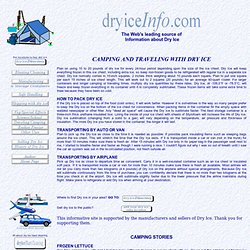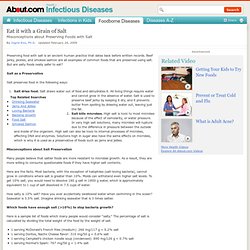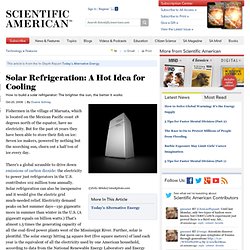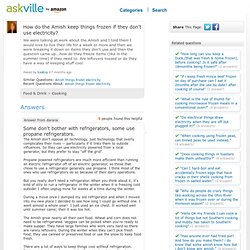

Extra super-creative stuff. DRY-ICE it. Keep Food Safe Using Dry Ice During a Power Outage. Dry Ice for Camping and Traveling. Plan on using 10 to 20 pounds of dry ice for every 24-hour period depending upon the size of the ice chest.

Dry Ice will keep everything frozen in this ice chest, including extra ice, so keep non-frozen goods to be refrigerated with regular ice in a separate ice chest. Dry Ice normally comes in 10-inch squares, 2 inches thick weighing about 10 pounds each square. Plan to put one square per each 15 inches of ice chest length. Preserve meat with no Fridge. Keep food WITHOUT refrig. nuts and botls. More on preserving Food. No Fridge PRESEVATION of Foods. Preserve it with sugar. More about it. Photo: Uwe Hermann (Flickr) Sugar is one of the most basic foods for all life - bacteria and mold like to eat it just as much as we do.

Some methods of preserving food are easy to understand. For example, it’s easy to see that freezing your food, or packing it in salt, would make it inhospitable to the microbes which would otherwise cause it to spoil. You might wonder, however, about jams, jellies, and preserves, all of which are protected from spoiling by a high concentration of sugar. Sugar is one of the most basic foods for all life – bacteria and mold like to eat it just as much as we do. Preserve it with salt. Preserving food with salt is an ancient human practice that dates back before written records.

Beef jerky, pickles, and smoked salmon are all examples of common foods that are preserved using salt. But are salty foods really safer to eat? Salt as a Preservative Salt preserves food in the following ways: Salt dries food. More about it. The Manaual. Invention and Innovation in Refrigiration DIY. Many readers of this magazine live in remote settings and generate their own electricity, often through solar, hydro, wind, or generator machines, storing the electricity generated in batteries.

In such a scenario the electricity produced is dear and needs to be used efficiently. ThermoDynamic Design. DIY Super Energy Efficient Refrigerator - Hack Your Own Ambient Air Fridge. Mini USB Fridge! On the Cheap :D. USB minuscule Fridge. Physics, how we love you.

You keep our feet on the ground, ontologically-ambiguous cats locked in boxes and photons in two places at the same time. It also enables the Peltier effect, what's that we hear you breathlessly ask? If a current is passed between two different materials a heat differential is created; one side hot the other cold. How to make a USB mini fridge. DIY Peltier Portable Refrigerator. Hot for cooling: The Solar Fridge. Fishermen in the village of Maruata, which is located on the Mexican Pacific coast 18 degrees north of the equator, have no electricity.

But for the past 16 years they have been able to store their fish on ice: Seven ice makers, powered by nothing but the scorching sun, churn out a half ton of ice every day. There's a global scramble to drive down emissions of carbon dioxide: the electricity to power just refrigerators in the U.S. contributes 102 million tons annually. Solar refrigeration can also be inexpensive and it would give the electric grid much-needed relief. Electricity demand peaks on hot summer days—150 gigawatts more in summer than winter in the U.S. (A gigawatt equals on billion watts.) Green Design. Proving once again that the best ideas are often the simplest, 21-year-old student/inventor/entrepreneur Emily Cummins has designed a brilliant portable solar-powered refrigerator that works based upon the principle of evaporation.

Employing a combination of conduction and convection, the refrigerator requires no electricity and can be made from commonly available materials like cardboard, sand, and recycled metal. Simply place perishable foods or temperature-sensitive medications in the solar refrigerator’s interior metal chamber and seal it. In-between the inner and outer chamber, organic material like sand, wool or soil is then saturated with water. As the sun warms the organic material, water evaporates, reducing the temperature of the inner chamber to a cool, 6 ºC [43 ºF] for days at a time! Further. By Chris Brooke Updated: 02:41 GMT, 8 January 2009.

Creative and Cooperative. GOOD STUFF. Elucidation: DIY. Much more details on the solar thing. Keeping Cool With Solar-Powered Refrigeration. NASA Insight. Over the last decade, some extremely "green" individuals have started giving up artificial refrigeration to save the Earth.

Or at least to save a few hundred kilowatt-hours a year. Most people think such a backward step in the evolution of modern civilization is a bit uncalled for, but it does draw attention to the drawbacks of modern refrigeration techniques. But there are other options besides resigning yourself to warm beer. Solar-powered refrigerators are pretty easy to come by these days, and they get around the energy-consumption issues associated with traditional fridges. They also get around the fact that 2 billion people around the globe have no access to electricity in the first place [source: NASA].
Solar energy, often known as photovoltaics, is ubiquitous these days. One of the most common solar-powered refrigerators on the market, the NASA-licensed SunDanzer, uses this PV technology to power an otherwise mostly traditional refrigeration setup. Propane Refrigirators. The Amish don't oppose all technology, just technology that overly complicates their lives -- particularly if it links them to outside influences.

So they can use electricity powered from a local generator, but they prefer to stay "off the grid". On the margin 1. 2. Vintage Coleman cooler (photo by Caffinara on Flickr) T he year I was born, 1965, Coleman® introduced the popular steel-sided ice chest that I imagine many of us grew with, camping with our families. I imagine that it wasn’t all that great, compared to some of today’s high-tech plastic coolers, but it was as much a part of my early camping experience as the smell of kerosene from the camp stove and I kind of miss its retro-simplicity. Unlike 1965, we have a lot of choices these days, when it comes to keeping our camping food cold. 3. Keeping Your Cooler Cool. Not bad to check out. A solar refrigerator sounds great, but what exactly is it? _freeze_fruit. 4. Edit Article. 5. Is hot weather making you miserable? Fridge Maintenance.
A refrigerator is one of the few appliances in your home that runs continuously, day or night, keeping your food cold. Ahoy! You can survive without it (the fridge) The topic of green living is vast and variable. Fridge Alternatives. When refrigerators hit the market in the late 1800s, it was a huge leap forward for civilized living. It offered a simple solution to the problem of bacteria-laden, disease-causing old food, not to mention the issue of losing money buying food that went bad before people could eat it all. Useful hints. Handy remarks. Quite Useful for the Challenge I. Quite Useful for the Challenge II. About three months ago, we started an experiment. Dump the fridge for a cooler and a freezer..GREEEEEN :)
The ZEER pot: Brilliant cooling solution. More on ZEER pots.